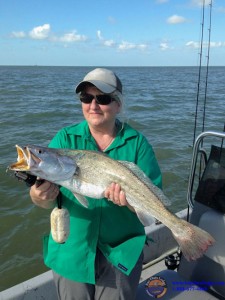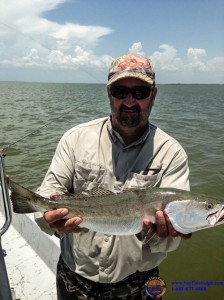
Trophy Trout by Cindy, fishing with Captain Boriske while visiting Bay Flags Lodge July 4th weekend; with live croaker in San Antonio Bay.
I’ve talked a bit in recent Guide Lines about how good fishing among oyster reefs can be during the really hot months of the year. What I haven’t talked a lot about is how I normally go about fishing these reefs. Now then, if you are fortunate enough to have become familiar with San Antonio Bay (SAB) and the Seadrift area, then you already know of all of the open-water shell that’s available to us on a regular basis. This may be the largest, and the finest, accumulation of oyster reefs that the Texas coast has to offer. These reefs are of all different shapes and sizes, and some of them have parts that are exposed above the water’s surface, while others remain completely submerged. All of these reefs are basically like miniature islands out in the middle of the bay, and each one is made-up of several parts – the reef walls, the crest, and what I refer to as the “points”. Because our predominant winds are of a southerly direction for a major portion of the time in our year, the reefs in SAB, which stretch from north to south, tend to have steeper walls, or sides, than those reefs, which run east to west. The north wall on an east-west reef will normally taper gently to the bay floor, whereas the south wall (the side exposed to the wind) will generally slope more steeply down to the bay floor, and it is often referred to as the “drop-off”. The crest of the reef is the highest point of the reef, and in the case of a submerged reef, receives a lot of the force of the bay currents and wave action. The ends of the reef are what I call the “points”, and each may taper slightly, or each may drop-off abruptly depending upon the physical layout of the reef, the winds, and the currents.
At the beginning of the summer when the days aren’t yet as hot as they are in July and August, I don’t tend to focus as much attention on whether I choose a submerged or exposed reef to start my day with. Instead, I concentrate on locating any reef, which happens to be offering me the preferred combination of active baitfish, a bit of mud underfoot, and immediate deep-water access for the fish. The consolidation of these three key ingredients will generally spell a recipe for success above these reefs. However, once July arrives, you’ll find me making it a point to start my initial morning wade session over a submerged reef before the sun comes up. Why a submerged reef, and why so early in the morning? Well, there are actually a couple reasons for this. The reason I prefer a submerged reef is that the fish tend to swim in the shallowest spots atop submerged reefs during night-time hours while they’re looking for a meal, or while they’re seeking shelter from night time predators in deeper water. And the reason for the pre-sunrise endeavor is to allow me to be able to take advantage of the cooler nighttime water temperatures of the shallowest spot of the submerged reef. Because the daylight hours at this time in the year heat shallow water so rapidly, it is important to beat the heat by advancing upon the reef just as early in the morning as possible.
Upon locating my reef of choice, I like to begin by positioning myself at a spot upon the reef that’s just within casting range of the crest of the reef. In doing this, I’m allowed the ability to experiment within the different levels of the entire water column. I might work a top water lure across the crest and onto the other side of the reef. I’ll place myself so as to be able to overshoot the crest of the reef by several feet, and then work my surface plug slowly across the shallowest point of the reef’s crest.
I’ll completely work the area immediately in front of me by making several casts from my 10 o’clock to my 2 o’clock positions. If I don’t experience any results, I’ll then shuffle down the reef about twenty feet in either direction, and then repeat the previous routine. Or, maybe I’ll choose to throw favored plastic bait from the crest of the reef and back along the downward contour, or perhaps even a crank-bait or a slow-sinker.
These are proven practices by which I have historically facilitated the process of pinpointing the bite above these reefs. If, or when, I determine that the bite is coming from deeper water that is located away from the crest of the reef, I prefer to begin examining the effects of some of the more popular suspending plastic and hard baits. I’m usually not able to cover as much water at the same rate of speed with these baits as I am when I use my standard plastic baits, but once I’ve located the bite, there’s little else that compares to the excitement.

